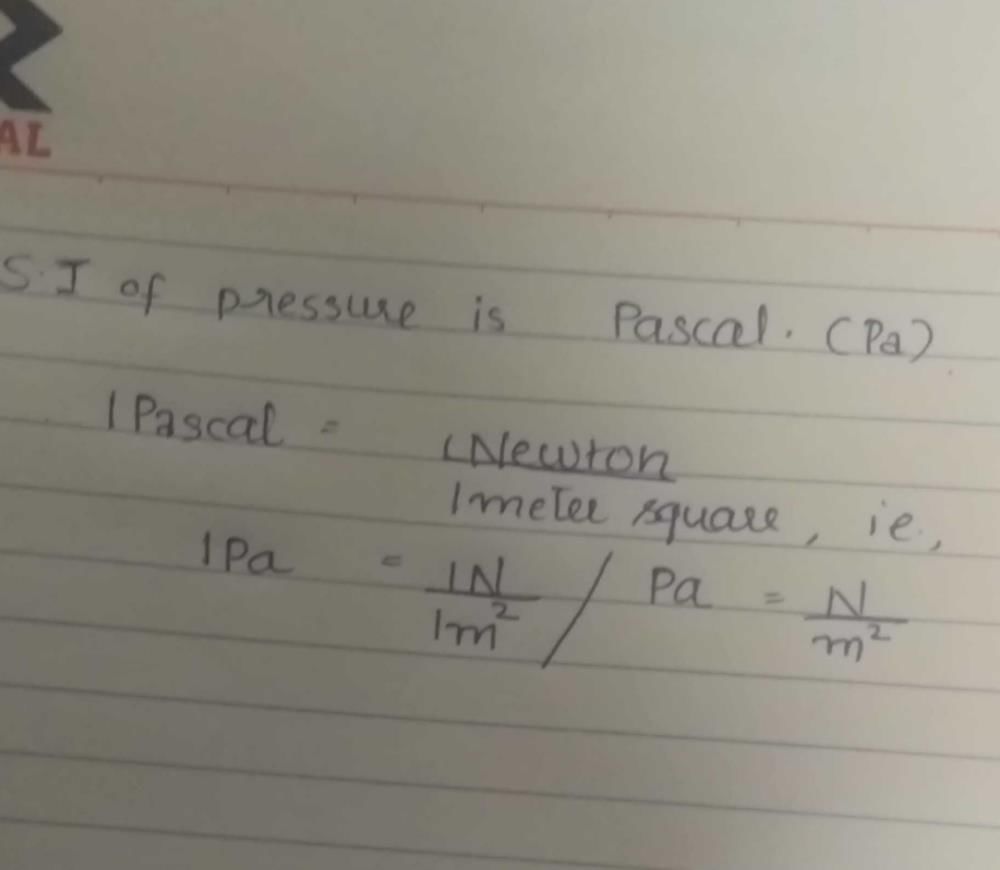Class 8 Exam > Class 8 Questions > What is the SI unit of pressure?
Start Learning for Free
What is the SI unit of pressure?
Most Upvoted Answer
What is the SI unit of pressure?
SI Unit of Pressure
Pressure is the force exerted per unit area. It is a fundamental parameter in physics, chemistry, and engineering. Pressure can be measured in different units, such as pounds per square inch (psi), atmospheres (atm), and millimeters of mercury (mmHg). However, the International System of Units (SI) defines the unit of pressure as the Pascal (Pa).
What is a Pascal?
The Pascal is the SI unit of pressure, named after the French mathematician and physicist Blaise Pascal. It is defined as the pressure exerted by a force of one Newton (N) on an area of one square meter (m²). Mathematically, one Pascal is equal to:
1 Pa = 1 N/m²
Advantages of Using Pascal as the Unit of Pressure
There are several advantages of using Pascal as the unit of pressure in scientific and engineering applications. Some of these advantages are:
- Standardization: Pascal is an internationally recognized unit of pressure, making it easy to compare and communicate results across different regions and disciplines.
- Simplicity: Pascal is a simple unit that is easy to understand and use in mathematical calculations.
- Compatibility: Pascal is compatible with other SI units of measurement, which simplifies the conversion of units and increases the accuracy of measurements.
Other Units of Pressure
Although Pascal is the SI unit of pressure, other units of pressure are still used in certain applications. Some of these units are:
- Bar: 1 bar = 10⁵ Pa
- Atmosphere: 1 atm = 101325 Pa
- Millimeters of Mercury: 1 mmHg = 133.322 Pa
Conclusion
The Pascal is the SI unit of pressure, defined as the pressure exerted by a force of one Newton on an area of one square meter. Pascal is a standardized, simple, and compatible unit that is widely used in scientific and engineering applications. Other units of pressure, such as bar, atmosphere, and millimeters of mercury, are still used in certain applications but can be converted to Pascal for easier comparison and communication of results.
Attention Class 8 Students!
To make sure you are not studying endlessly, EduRev has designed Class 8 study material, with Structured Courses, Videos, & Test Series. Plus get personalized analysis, doubt solving and improvement plans to achieve a great score in Class 8.

|
Explore Courses for Class 8 exam
|

|
What is the SI unit of pressure?
Question Description
What is the SI unit of pressure? for Class 8 2024 is part of Class 8 preparation. The Question and answers have been prepared according to the Class 8 exam syllabus. Information about What is the SI unit of pressure? covers all topics & solutions for Class 8 2024 Exam. Find important definitions, questions, meanings, examples, exercises and tests below for What is the SI unit of pressure?.
What is the SI unit of pressure? for Class 8 2024 is part of Class 8 preparation. The Question and answers have been prepared according to the Class 8 exam syllabus. Information about What is the SI unit of pressure? covers all topics & solutions for Class 8 2024 Exam. Find important definitions, questions, meanings, examples, exercises and tests below for What is the SI unit of pressure?.
Solutions for What is the SI unit of pressure? in English & in Hindi are available as part of our courses for Class 8.
Download more important topics, notes, lectures and mock test series for Class 8 Exam by signing up for free.
Here you can find the meaning of What is the SI unit of pressure? defined & explained in the simplest way possible. Besides giving the explanation of
What is the SI unit of pressure?, a detailed solution for What is the SI unit of pressure? has been provided alongside types of What is the SI unit of pressure? theory, EduRev gives you an
ample number of questions to practice What is the SI unit of pressure? tests, examples and also practice Class 8 tests.

|
Explore Courses for Class 8 exam
|

|
Suggested Free Tests
Signup for Free!
Signup to see your scores go up within 7 days! Learn & Practice with 1000+ FREE Notes, Videos & Tests.


























